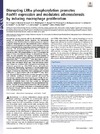Identificador persistente para citar o vincular este elemento:
https://accedacris.ulpgc.es/jspui/handle/10553/41940
| Título: | Disrupting lxrα phosphorylation promotes foxm1 expression and modulates atherosclerosis by inducing macrophage proliferation | Autores/as: | Gage, M. C. Bécares, N. Louie, R. Waddington, K. E. Zhang, Y. Tittanegro, T. H. Rodríguez-Lorenzo, S. Jathanna, A. Pourcet, B. Pello, O. M. De La Rosa, Juan Vladimir Castrillo, Antonio Pineda-Torra, I. |
Clasificación UNESCO: | 32 Ciencias médicas | Palabras clave: | Liver X receptor Atherosclerosis Macrophages Proliferation FoxM1 |
Fecha de publicación: | 2018 | Editor/a: | 0027-8424 | Publicación seriada: | Proceedings of the National Academy of Sciences of the United States of America | Resumen: | Macrophages are key immune cells for the initiation and development of atherosclerotic lesions. However, the macrophage regulatory nodes that determine how lesions progress in response to dietary challenges are not fully understood. Liver X receptors (LXRs) are sterol-regulated transcription factors that play a central role in atherosclerosis by integrating cholesterol homeostasis and immunity. LXR pharmacological activation elicits a robust antiatherosclerotic transcriptional program in macrophages that can be affected by LXRα S196 phosphorylation in vitro. To investigate the impact of these transcriptional changes in atherosclerosis development, we have generated mice carrying a Ser-to-Ala mutation in myeloid cells in the LDL receptor (LDLR)-deficient atherosclerotic background (M-S196ALdlr-KO). M-S196ALdlr-KOmice fed a high-fat diet exhibit increased atherosclerotic plaque burden and lesions with smaller necrotic cores and thinner fibrous caps. These diet-induced phenotypic changes are consistent with a reprogramed macrophage transcriptome promoted by LXRα-S196A during atherosclerosis development. Remarkably, expression of several proliferation-promoting factors, including the protooncogene FoxM1 and its targets, is induced by LXRα-S196A. This is consistent with increased proliferation of plaque-resident cells in M-S196ALdlr-KOmice. Moreover, disrupted LXRα phosphorylation increases expression of phagocytic molecules, resulting in increased apoptotic cell removal by macrophages, explaining the reduced necrotic cores. Finally, the macrophage transcriptome promoted by LXRα-S196A under dietary perturbation is markedly distinct from that revealed by LXR ligand activation, highlighting the singularity of this posttranslational modification. Overall, our findings demonstrate that LXRα phosphorylation at S196 is an important determinant of atherosclerotic plaque development through selective changes in gene transcription that affect multiple pathways. | URI: | https://accedacris.ulpgc.es/handle/10553/41940 | ISSN: | 0027-8424 | DOI: | 10.1073/pnas.1721245115 | Fuente: | Proceedings of the National Academy of Sciences of the United States of America [ISSN 0027-8424], v. 115, p. E6556-E6565 |
| Colección: | Artículos |
Citas SCOPUSTM
40
actualizado el 08-jun-2025
Citas de WEB OF SCIENCETM
Citations
40
actualizado el 08-jun-2025
Visitas
78
actualizado el 28-sep-2024
Descargas
111
actualizado el 28-sep-2024
Google ScholarTM
Verifica
Altmetric
Comparte
Exporta metadatos
Los elementos en ULPGC accedaCRIS están protegidos por derechos de autor con todos los derechos reservados, a menos que se indique lo contrario.
